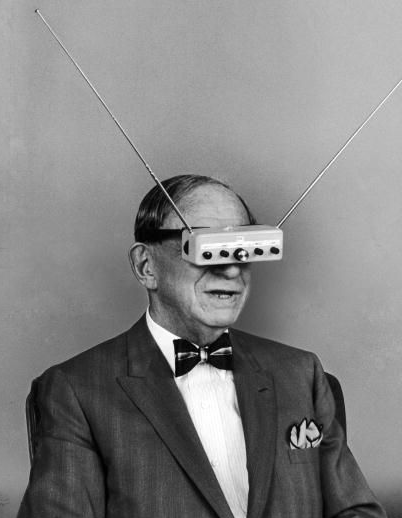Hugo Gernsback may have been America’s first professional futurist, and while he wasn’t always right he was always interesting. Gernsback invented the first home radio kits right after the turn of the nineteenth century and sold his gadgets by mail order from his Brooklyn offices. He loved science fiction as much as science–saw them as complements, really–and published some of the earliest examples of the form in his publications, including Amazing Stories. He coined the term “television,” and when he wasn’t explaining the concept to 1920s newbies, he was conducting early broadcasts, an expensive endeavor that helped bankrupt him.
Just four years before his death, the July 26, 1963 issue of Life profiled the man in “Barnum of the Space Age,” which reported his prophecies for the future. The opening:
Science is now so big, so flamboyant and so barnacled with politicians, press agents, generals and industrialists that Hugo Gernsback, who invented it back in 1908 (and has re-invented it, annually, since) can scarcely make himself heard above the babble of the late-comers. Although he is now 78, Gernsback is still a man of remarkable energy who raps out forecasts of future scientific wonders with the rapidity of a disintegrator gun. He believes that millions will eventually wear television eyeglasses–and has begun work on a model to speed the day. “Instant newspapers” will be printed in U.S. homes by electromagnetic waves, in his opinion, as soon as U.S. publishers wrench themselves out of the pit of stagnant thinking in which Gernsback feels they are wallowing at present. He also believes in the inevitability of teleportation–i.e., reproducing a ham sandwich at a distance by electronic means, much as images are now reproduced on a television screen.Gernsback pays absolutely no attention, while issuing such pronunciamentos, to the fact that the public is rapidly becoming inured to scientific advance and that scientists themselves may not actually stand in need of his advice and counsel. He paid as little attention to the head-tapping some of his announcements set of in the 1920s–a period in which he was often considered nuttier than Albert Einstein himself.
Gernsback, in fact, has felt himself impelled to preach the gospel of science ever since his youth in Luxembourg–not so much, apparently, for the good of science as for his own satisfaction and the delights of seeing his name in the papers. In 55 years as a self-appointed missionary, he has stiffly ignored both the cackling of the heathen and the cries of competing apostles. Moreover, as founder, owner, and guiding spirit of Gernsback Publications, Inc., a New York-based publishing enterprise which has produced a succession of scientific and technical books and magazines (among them Amazing Stories, the first science-fiction monthly), he has not only provided himself with a method of firing endless barrages of opinion, criticism and augury but the means of making a good deal of money as well.
Neither Gernsback’s instinct for the unorthodox, however, nor his unabashed sense of theater has prevented his full acceptance as a member of the science community. Dozens of today’s top scientists were attracted to their calling by reading his magazines as boys, and a good many–including Dr. Donald H. Menzel, director of the Harvard Observatory– earned money for college tuition by writing for them. He is heralded as the “Father” of modern science fiction (the statuettes which are annually awarded to its top writers are, in his honor, known as Hugos, but he is simultaneously a member of the American Physical Society and a lecturer before similar learned groups. The greatest inventors and scientists of the early 20th Century–among them Marconi, Edison, Tesla, Goddard, DeForest and Oberth–corresponded freely with him and came, in many cases, to admire and confide in him as well. The Space Age caused no diminution of this cozy relationship with the great; RCA’s General David Sarnoff is among his friends and pen pals, and so are former Atomic Energy Commissioner Lewis L. Strauss and President Kennedy’s science adviser, Dr. Jerome Wiesner.
This admiration is solidly based. Gernsback, in his unique career, has not only done his best to prepare the public mind for the “wonders” of science but has sometimes managed to tell science itself just what wonders it was about to produce. for instance, he conceived the essential principles of radar aircraft detection in 1911–a year when the airplane itself was barely able to stagger off the ground. This early concept was so complete that Sir Robert Watson-Watt, whose radar tracking devices helped save London in the Battle of Britain, considers him the original inventor.
Gernsback not only coined the word “television” (he refuses to accept credit for that since he has discovered a Frenchman used an equivalent of the word a little earlier) but in 1928, as owner of New York’s radio Station WRNY, actually instituted daily telecasts with crude equipment. His list of successful scientific prophecies is almost endless and the perspicacity with which he has reported scientific thinking on the part of others is remarkable. In the 1920s, to make the point, he was force-feeding his readers all sorts of crazy stuff about atomic energy and about the problems of weightlessness and orbital rendezvous to be encountered in “space flying.”
It is, therefore, difficult not to believe that U.S. science has been influenced in many ways as a result of Gernsback’s extraordinary career in evangelism…•

